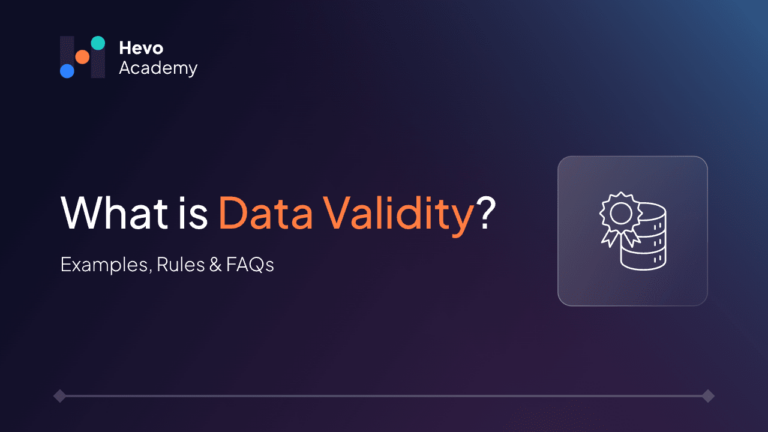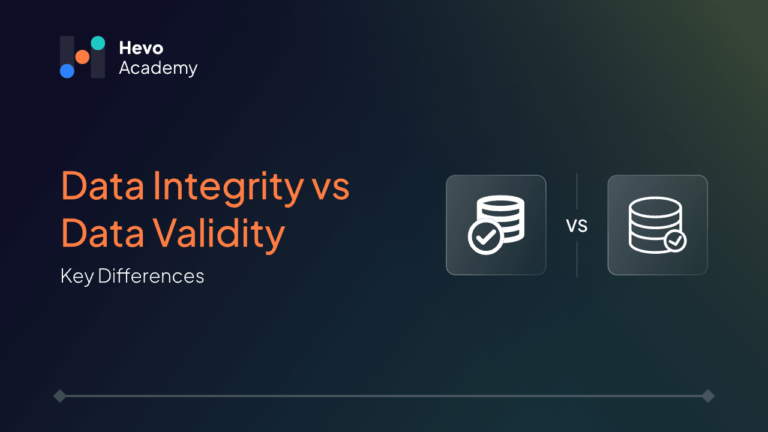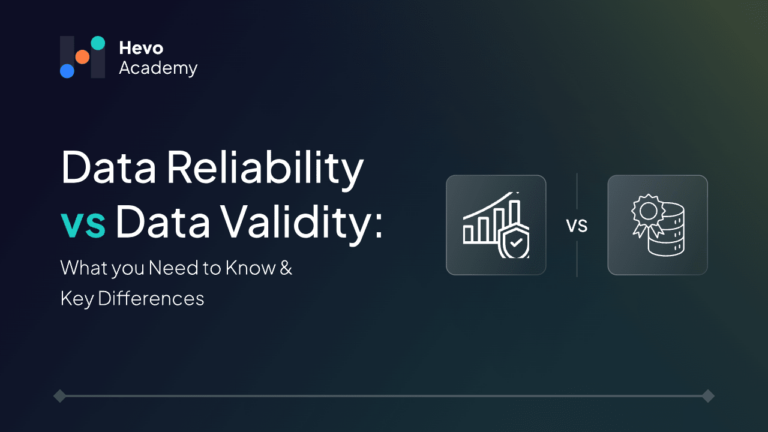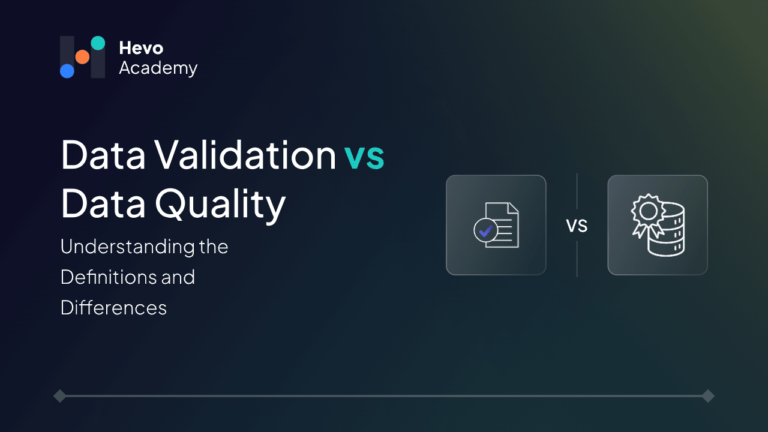According to a recent Gartner study, poor data quality can cost organizations an average of $12.9 million annually. Hence, good data quality is absolutely essential to ensure that the data is reliable for consumption and decision making. Data validity is one of the major data quality dimensions, and we will cover its importance, real-life examples, consequences as well as how to perform data validation in this article.
Table of Contents
What is Data Validity?
With the advent of big data, more and more organizations are recognizing its value and are using it to make well-informed decisions, and gain an edge over their competitors. But what if the data they are using is not accurate or valid?
This is where data validity comes into picture. It is the process of checking how reliable and accurate the data is within a given dataset. The data is checked against certain rules and standards to make sure that the data is in the correct format as well as reliable.
Importance of Data Validation
Most organizations utilize data in one form or another to run their business and make decisions. Poor quality of data will render the outcome decisions as inaccurate as well. This can lead to huge loss of time and resources, as well as impact customer satisfaction.
Data validity is especially impactful in domains like finance, customer targeting and customer support. It is a crucial measure to ascertain that the data can be used by the end-users for decision making. Data validation is essential for better customer experience and optimized business operations by keeping in mind essential data quality checks. Get a detailed comparison of data validation vs. data quality using a full guide on the distinctions between these.
Example of Valid Data and Invalid Data
Invalid data refers to data which has missing values, duplicates, outliers, anomalies or inconsistencies. Invalid data can compromise the overall data quality and hence, it is important to distinguish between what constitutes valid and invalid data.
Below table covers some examples of valid and invalid data:
| Data Type | Valid Data | Invalid Data |
| Human Age | 5, 5 years, 6 months | 1030, -43, Apple |
| Email ID | johndoe@gmail.com | 1234@google, john@.com |
| Country | USA, United States of America, India | U$A, New York, Pizza |
| Date | 01/01/2000, 1st January 2000 | 15/15/2015, 40th January 200202 |
| Bill amount | $56.60 | 56$60, 56$, $56.50.60 |
Consequences of Invalid Data
There can be multiple reasons for how data can be invalid. It can be due to human errors during data entry, missing or incomplete values, and inconsistency in data formatting. Invalid data can have some major consequences, some of which are as mentioned below:
- Inaccurate decision making: Invalid data will affect how the decisions are made and can lead to incorrect business outcomes since the data used would not be reliable.
- Inaccurate analytics and prediction: Major outliers and anomalies in data can affect the data analysis and how it is used for prediction and recommendation systems.
- Waste of time and resources: The time, energy and resources spent on analyzing invalid data is a huge loss for any organization as it cannot be utilized for making informed decisions.
- Loss of trust: Invalid data can lead to inaccurate decision making, which will ultimately affect the customer’s trust in the organization and affect their reputation.
- Compliance issues: Invalid data can lead to non-compliance with laws and regulations, especially in domains like finance and healthcare. This can result in legal action or fines for the organization.
How to Perform Data Validation?
Now that we have understood the importance of data validation, let us explore how we can ensure that the data is valid and reliable. Below are some of the ways in which we can perform data validation on our data:
- Ensure that the data source is reliable. We can employ the end-users or business SMEs to check whether a sample data is accurate. Compare data reliability with data validity and make informed decisions.
- Use data validation scripts. We can implement a set of rules that the data must meet before it is utilized. This can include rules like length checks or data type limitations.
- Implement anomaly detection. We should use visualizations to detect outliers in the data. We can also utilize anomaly detection tools to identify data points that fall outside the expected range.
- Implement statistical measures. We can run statistical tests like correlation analysis, sampling and p-value tests to detect data anomalies.
- Use hypothesis and real-world testing. We can run controlled experiments to verify whether the data supports our hypothesis. We can also validate the results under actual operational conditions.
- Set up regular audits and feedback loops. We can implement automated data quality checks to detect inconsistencies in data. We can also gather continuous feedback from the end-users to ensure that the data is relevant.
Data Validation Rules
Data validation rules are specific controls that check the format of the data, and ensure its validity by enforcing constraints during data input. Some of the commonly used data validation rules are as follows:
- Type validation: It confirms that the data entered is of the correct data type (e.g., age should only be numeric data).
- Range validation: It ensures that the data lies in the correct range, or comes from a valid list of values (e.g., months in a year should only be in the range 1-12, or contain valid values from January to December)..
- Length validation: It ensures that the data is within the permissible length and follows any character limitations (e.g., passwords must be more than 8 characters and include at least one uppercase, lowercase and numeric character).
- Field validation: It ensures that a particular data field is non-empty (e.g., name should not be empty in an employee database).
- Regex or Format validation: It ensures that the data matches a particular pattern (e.g., an email ID must have a username, followed by an @ symbol and the domain provider).
- Uniqueness validation: It ensures that all the records in a given field are unique (e.g., the employee ID for every employee in an organization must be unique).
- Cross-field validation: It ensures that the combination of a given set of fields is valid (e.g., the end date of an event must be after the start date).
These data validation rules can be applied using custom code scripts. Implementing these rules helps to minimize human error and maintain the reliability of the data. It is vital to validate the data against these rules so that one can confidently make data-driven decisions. Data quality rules ensure that the data meets the necessary standards of accuracy, completeness, and consistency before being used for analysis or decision-making.
Conclusion
As organizations continue to use data for making business decisions, it is absolutely essential to ensure that the data is valid and reliable for consumption. Invalid data can lead to potential loss of trust, competitive edge and customer satisfaction. Hence, we must employ data validation techniques like anomaly and outlier detection, data quality checks and automated scripts for ensuring data validity. This will not only help the businesses improve their decision making but also help them grow and make their operations more efficient.
Try Hevo for no-code, zero-maintenance data integration, and keep your data teams up to date. Sign up for a 14-day free trial today.
FAQ
1. How do you check data validity?
We can check data validity by implementing statistical tests, visualizations, anomaly detection, data validation scripts and also via third-party tools. We can do hypothesis testing on sample data, as well as set up data quality and audit checks to gather feedback on the data.
2. What is validity vs reliability of data?
Data validity refers to the accuracy of the data and whether it represents the measure correctly. Data reliability refers to consistency of the data and whether the data and its outcomes will be stable over time, and can be reproduced under the same conditions.
3. What are the criteria for data validity?
Some of the criteria for data validity include checking whether it falls in the appropriate range (e.g., months in a year can only be from 1 to 12), is in the correct format (e.g., date should be in DD-MM-YYYY format) and if the data is consistent.






